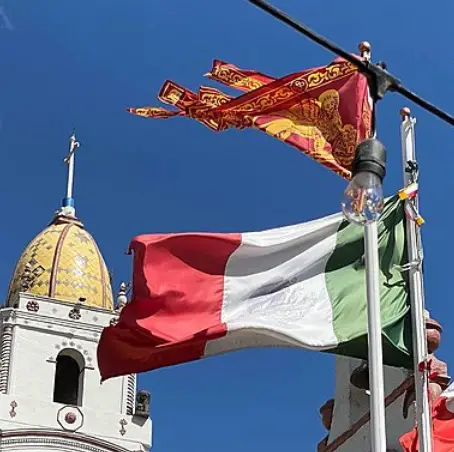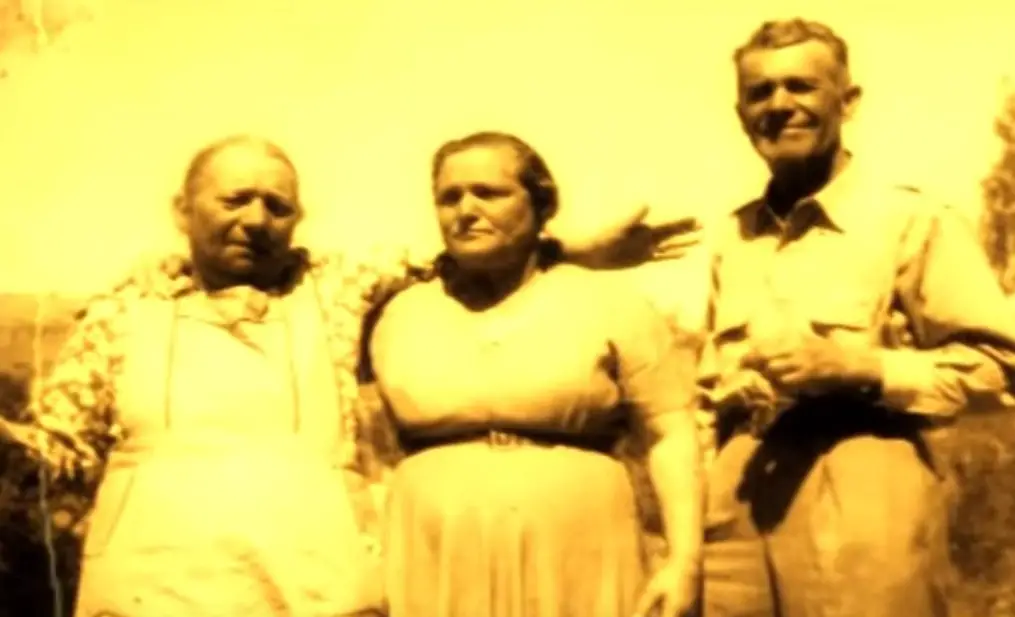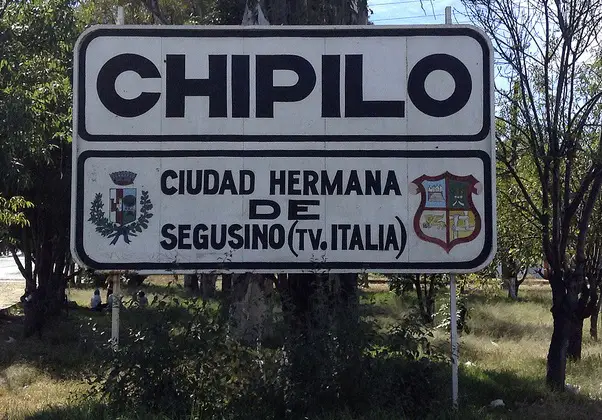Podcast: Play in new window | Download
Subscribe: Apple Podcasts | RSS
 Here are the words of the award-winning Mexican author and linguist, Eduardo Montagner Anguiano, who was born and raised in the town of Chipilo, in the Mexican state of Puebla:
Here are the words of the award-winning Mexican author and linguist, Eduardo Montagner Anguiano, who was born and raised in the town of Chipilo, in the Mexican state of Puebla:
“Chipilo preserves the features, culture, and dialect of the Italian origin. For linguists, Chipilo is a treasure: the rare case of a town that is transported to another country, and that keeps its language and customs almost intact, as they were in the 19th century. To its Mexican neighbors, Chipilo is a strange place of sturdy, blond, red-haired, and unusually thrifty and prosperous peasants. In the streets there are no children playing ‘cascaritas’, nor police officers; There are no pints or election banners, no trash, and no grocery stores on every corner. There is a Salesian convent, three schools, the Casa de Italia, a library, the presidency, a sausage, cold meat, and cheese shop, and a couple of cafes. There are two banks, a fleet of relatively new cars, concrete paved streets, and stables and carpentry in the backyard of each house. While many of the Mexican neighbors lack modern services, all of the Chipileños have houses with water, drainage, electricity, and education.”
While some of what Anguiano wrote was the boasting of a native son of Chipilo, the town is indeed interesting and is unique in Mexico. Located some 12 miles west of the city of Puebla, the capital of the Mexican state of the same name has grown out to meet this town and some would consider Chipilo a suburb of the capital city. This was not always the case, and Chipilo’s relative isolation up until the late 20th Century was responsible for the preservation of its distinct culture and language. So, how did this Italian colony in the center of Mexico come to be?
Chipilo was not the first Italian colony in Mexico. Right after independence, the new nation of Mexico talked about bringing in European colonists, specifically Italians, to settle the Isthmus of Tehuantepec and also the far-flung province of Texas. Italians were Catholic and considered industrious, and the similarities between Spanish and the languages spoken in the Italian Peninsula were also a plus. In 1857, Mexican President Ignacio Comonfort issued a regalmento, or land grant, for a small colony of Italians to be established on the banks of the Tecolutla River in the state of Veracruz. The colonists were to come from the city of Genoa, which was then part of the Kingdom of Savoy-Sardinia in the years before Italian Unification. The Consul for the Kingdom of Savoy-Sardinia in Mexico, Giovanni Musso, signed the contract along with Luigi Masi who was to represent the Italian settlers in Mexico. In late 1857, a few dozen families arrived at Veracruz from Genoa and founded the city named Cristo. The colony failed, however, because the climate was too tropical for the majority of the settlers. Most of these colonists returned to Italy, but some moved to the larger cities of Mexico and eventually blended into the general Mestizo population.
 In the early 1880s, under the rule of Porfirio Díaz, Mexico renewed its efforts to attract Italian immigrants. In addition to Chipilo, there were 5 other Italian colonies founded within the Federal District of Mexico and sponsored by the federal government. Their names were: Porfirio Díaz, Carlos Pacheco, Fernández Leal, Díez Guitiérrez and Aldama. The government paid for the colonists’ passage to Mexico, and when they arrived the government also gave the settlers cash advances for tools, seeds, and daily needs, to be repaid with the first harvest. These five colonies either experienced various degrees of collapse or lost their “Italianness” over time as indigenous and mestizo Mexicans from the surrounding areas moved in. As an aside, the modern-day town called Nueva Italia, which translates to “New Italy,” located in the state of Michoacán, was never a colony of Italians like the others previously described. Nueva Italia began as a large ranch founded by Italian immigrant Dante Cusi in 1909. With its complex and extensive system of irrigation, Nueva Italia became the single leading producer of cotton, rice, melons, and corn in all Mexico. A small town of agricultural workers grew up around the ranch comprised wholly of local Mexicans and migrants from Sinaloa and Guerrero, not Italy.
In the early 1880s, under the rule of Porfirio Díaz, Mexico renewed its efforts to attract Italian immigrants. In addition to Chipilo, there were 5 other Italian colonies founded within the Federal District of Mexico and sponsored by the federal government. Their names were: Porfirio Díaz, Carlos Pacheco, Fernández Leal, Díez Guitiérrez and Aldama. The government paid for the colonists’ passage to Mexico, and when they arrived the government also gave the settlers cash advances for tools, seeds, and daily needs, to be repaid with the first harvest. These five colonies either experienced various degrees of collapse or lost their “Italianness” over time as indigenous and mestizo Mexicans from the surrounding areas moved in. As an aside, the modern-day town called Nueva Italia, which translates to “New Italy,” located in the state of Michoacán, was never a colony of Italians like the others previously described. Nueva Italia began as a large ranch founded by Italian immigrant Dante Cusi in 1909. With its complex and extensive system of irrigation, Nueva Italia became the single leading producer of cotton, rice, melons, and corn in all Mexico. A small town of agricultural workers grew up around the ranch comprised wholly of local Mexicans and migrants from Sinaloa and Guerrero, not Italy.
With the help of agents and the federal government, the state of Puebla sought to attract their own colony of Italians in 1882. They selected a tract of land near a place to the west of the capital city which had been known since ancient times as “Chipilac.” The word chipilac in the local dialect of Nahuatl loosely translates to “place of the whiner.” Because the area was so infested with bandits and other assorted outlaws, Chipilac, also called Chipilo, was often referred to as “Quitacalzones,” which loosely translates to, “Take off your pants.” Led by a man named Angelo Zanella, colonists came to Chipilo from Treviso, a comune or municipality north of Venice, on October 6, 1882. In the words of American researcher James Passarelli, “The colonists thought they were coming to the El Dorado of their dreams where all they had to do was to turn a spadeful of dirt to get rich crops.” Although the Italians were promised cultivatable land, Chipilo is located in a very dry region and farming was very difficult, if not impossible. Because of this, and due to constant run-ins with local Otomi natives, only forty of the original 100 Italian families remained. Many stayed because they could not pay for their passage back to Italy. A few families migrated to other parts of Mexico. The 40 that stayed in Chipilo made the best of it and turned land not suitable for agriculture into grazing land. By the early 20th Century, the town was a dairy powerhouse, supplying over 10,000 liters of milk shipped to Mexico City each day. These colonists were very prolific if not industrious, with some families having eighteen children. By the 1940s, those 40 families had turned into a town of over 3,000 inhabitants. Today there are over 4,000 people living in Chipilo with most of them descended from the original Venetian settlers.
 During the Mexican Revolution, the town of Chipilo remained neutral. There is a story still told by locals, that in 1910 a lavish wedding was being held in town uniting two prominent local families. The celebration was so large that Carranza and Zapatista soldiers, and even generals, intermingled at the event and even got drunk together without even knowing the company they were keeping. In the final years of the Revolution, with most of the fighting passing them by, the people of Chipilo began several improvements to the town. In 1915 an Italian school was founded by Salesian nuns from Turin, Italy, the first school ever opened in Chipilo. That same year, 1915, residents of the town constructed a meeting hall for various functions called the Casa Italia, which still stands proudly to this day. In 1931 the Mexican government intruded into the lives of the Chipileños and built a school in the town where Spanish was the official language of instruction. By this time, most of the people in Chipilo were still speaking the dialect of the Venetian language that the original settlers had spoken when they arrived some 50 years before.
During the Mexican Revolution, the town of Chipilo remained neutral. There is a story still told by locals, that in 1910 a lavish wedding was being held in town uniting two prominent local families. The celebration was so large that Carranza and Zapatista soldiers, and even generals, intermingled at the event and even got drunk together without even knowing the company they were keeping. In the final years of the Revolution, with most of the fighting passing them by, the people of Chipilo began several improvements to the town. In 1915 an Italian school was founded by Salesian nuns from Turin, Italy, the first school ever opened in Chipilo. That same year, 1915, residents of the town constructed a meeting hall for various functions called the Casa Italia, which still stands proudly to this day. In 1931 the Mexican government intruded into the lives of the Chipileños and built a school in the town where Spanish was the official language of instruction. By this time, most of the people in Chipilo were still speaking the dialect of the Venetian language that the original settlers had spoken when they arrived some 50 years before.
In the 21st Century the language spoken in Chipilo and by those Chipileños who have located to other parts of Mexico and to the US, has undergone great examination by linguists, historians, and even Mexican government officials. The original colonists were almost exclusively from the comune or municipality of Treviso north of the city of Venice. As an aside, there are two notable things about Treviso: Clothing retailer Benneton is headquartered there, and the popular Italian dessert Tiramisu was invented there. The people of Treviso still speak a dialect of Venetian which is a Romance language in its own right and separate from Italian. Some people call Venetian a dialect of Italian, but it is not; it’s a distinct language. The Treviso variant of Venetian is called “Northern Feltrino-Bellunese” by hardcore linguists. This rare dialect  spoken in and around Treviso has been somewhat overrun by mainstream Venetian and even more by Italy’s national language, Italian. Like so many other indigenous languages around the world, younger people have no interest in learning or using this obscure dialect. As a language isolate in Mexico, the Treviso variant of Venetian spoken in Chipilo has remained more true to form than the same language spoken in its original homeland, especially among the elders of the Mexican town. The Treviso dialect of this dying Romance language called Venetian has managed to be preserved in Mexico by its lack of contact with the outside world. Like many of the indigenous languages in Mexico and like its cousin in Italy, the unique language spoken in Chipilo – now called by linguists “Chipilo Venetian” – is in danger of facing a slow die-off, as the community opens itself up more to the outside world and adopts a more global perspective. Many leaders in the town and their advocates, some at the national level, have asked the Mexican government to put the Chipilo Venetian language on the list of protected languages in Mexico. With this status comes government funding and other resources to ensure language preservation. It also comes with attention and awareness, which are also important. Cultural exchanges with Italy have also helped foster interest in language preservation and have encouraged Chipileños to write poetry and other forms of literature in their unique dialect of Venetian. Although facing pressures from modern society, the town of Chipilo will most likely maintain its unique culture and language for the foreseeable future, thus continuing to contribute to the diversity that enriches the country of Mexico.
spoken in and around Treviso has been somewhat overrun by mainstream Venetian and even more by Italy’s national language, Italian. Like so many other indigenous languages around the world, younger people have no interest in learning or using this obscure dialect. As a language isolate in Mexico, the Treviso variant of Venetian spoken in Chipilo has remained more true to form than the same language spoken in its original homeland, especially among the elders of the Mexican town. The Treviso dialect of this dying Romance language called Venetian has managed to be preserved in Mexico by its lack of contact with the outside world. Like many of the indigenous languages in Mexico and like its cousin in Italy, the unique language spoken in Chipilo – now called by linguists “Chipilo Venetian” – is in danger of facing a slow die-off, as the community opens itself up more to the outside world and adopts a more global perspective. Many leaders in the town and their advocates, some at the national level, have asked the Mexican government to put the Chipilo Venetian language on the list of protected languages in Mexico. With this status comes government funding and other resources to ensure language preservation. It also comes with attention and awareness, which are also important. Cultural exchanges with Italy have also helped foster interest in language preservation and have encouraged Chipileños to write poetry and other forms of literature in their unique dialect of Venetian. Although facing pressures from modern society, the town of Chipilo will most likely maintain its unique culture and language for the foreseeable future, thus continuing to contribute to the diversity that enriches the country of Mexico.
REFERECES
Passarelli, James J. “Italy in Mexico: Chipilo.” Italica, vol. 23, no. 1, 1946, pp. 40–45
